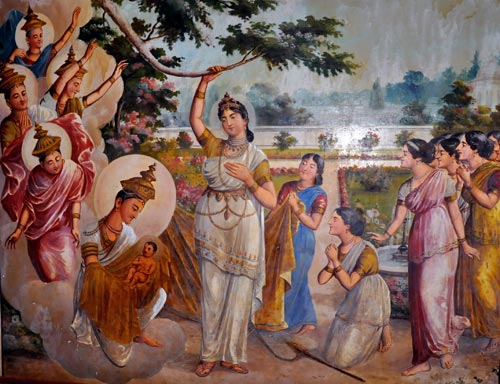Vesak: A time to reflect on the Buddha’s teachings

Isipathanaramaya, Colombo: A painting depicting the birth of Prince Siddhartha
Vesak is also known as Vaishaka, Buddha Jayanthi, and Buddha Purnima. On Thursday (May 23) , Buddhist devotees will commemorate the three main milestones in the life of the Buddha: the birth of Siddhartha Gautama in Lumbini Sal Uyana (Park) at the foothills of the Himalayan mountains in Nepal; the Supreme Enlightenment in Gaya, India; and Parinibbhana (passing away) in the Upavarthana Sala Park of the Malla Kings in Kusinara. After discoursing the Dhamma for 45 years, the Buddha passed away at the age of eighty years. His last words at his Parinibbhana were: Appamadetha Sampadetha Vaya Dhamma Sankara (all component things are impermanent. Work diligently for your liberation – work out your own salvation).
Vesak is celebrated as a religious and cultural festival with ãmisa pooja (rituals, offering flowers, lighting lamps, etc.) and prathipatthi pooja (practicing the Dhamma following instructions laid by the Buddha by meditating to develop the mind).
Siddhartha Gautama, seated under the Asatu tree in Gaya, after deep meditation of Anapanasati Bhavana (breathing in and out), attained Supreme Enlightenment (Bodhi) under this tree, which came to be known as the Bodhi Tree. On His enlightenment, he realised the Four Noble Truths of Dukka (suffering), Dukata Hetuwa (cause of suffering), Duka Nethikireema (cessation of suffering), and Duka netikireeme margaya (path leading to the cessation of suffering—the Noble Eightfold Path).
The Buddha’s first discourse, the Dhammacakkapavattana Sutta, was addressed to the five ascetics at Sarnath, explaining the Four Noble Truths and the Noble Eightfold Path: right understanding, right thought, right speech, right action, right livelihood, right effort, right mindfulness, and right concentration. These are divided into three groups as prajna (wisdom), Sila (morality), and Samadhi (concentration). He advised that one should not practice the two extremes of kamasukallikanuyogaya (too much sensual pleasure) and attakilomathanuyyoga (subjecting oneself to pain and deprivation), but, follow the Middle Path to strive to attain Nibbana, to be released from multiple births in one’s samsaric journey. Therefore, the Four Noble Truths are considered the essence of the Buddha’s teachings.
It is mentioned in Buddhist history that the Buddha graced the island of Lanka on three occasions. First to Mahiyangana after the ninth month of His attaining Supreme Enlightenment, secondly to Nagadeepa to settle a dispute between an uncle and nephew, Mahodhara and Chulodhara over a jewelled throne, which was settled and the throne handed over to the Naga King Maniakkhitha. The third was at the invitation of Naga King Maniakkhitha, when the Buddha visited Kelaniya.
On this Vesak Full Moon Poya, thousands of devotees will visit temples to venerate and pay homage to the Buddha. They move away from unwholesome thoughts and deeds to follow the pancha sila (five precepts) that are the basic guidelines for devotees to understand the meaning and undertake to abstain from: 1. killing living creatures; 2. taking what is not given; 3. wrong sexual conduct; 4. false speech; and 5. taking intoxicants. These will help them lead a wholesome life.
Some devotees will observe ata sil (eight precepts), with three more precepts added on to the pancha sila, spending the whole day in the temple. They listen to discourses and meditate. They will concentrate on Metta Bhavana (radiating loving kindness to all beings) or Buddhanusruti bhavana (concentrating on the nine virtues of the Buddha). With the latter, devotees will remember the stanza, “Itipiso Bhaghava araham samma sambuddho vijja carana sampanno sugato lokavidu anuttaro purisadamma sarati sattha devmaussanam Buddho Bhagavati” and contemplate the nine great qualities of the Buddha.
Araham: The Buddha was free of all misconduct and completely destroyed desire. He is worthy of reverence and offerings.
Samma Sambuddho: He realised the four noble truths unaided by any teacher. He knew the true nature of all things. Rebirth will come to an end, eliminating desire, which will pave the way to Nibbana.
Vijja Charana Sampanno: The Buddha had the capability of seeing things near or far.
Sugato: The Buddha found the noble eight-fold path that leads to supreme bliss by eradicating anger, craving, and ignorance. He reached the highest bliss through virtue, concentration, and wisdom.
Lokavidu: He knew of the existence of three worlds: the space world, the aggregated elements, and the world of beings, and he said, “this fathom-long body, I do proclaim the world, the origin, the end, and the path leading to the end of the world.” He knew the world and preached the way out, to end suffering.
Anuttaro purisa dhamma sarathi: His wisdom is incomparable; he is the most virtuous person on earth. He was able to transform miscreants into morally good beings.
Sattha deva manussanam: The Buddha is the teacher to devas and humans.
Buddho: Unaided by anyone, by His own effort, realised the Four Noble Truths.
Vesak Full Moon Poya also marks the end of the Sripada (Adam’s Peak) season in Sri Lanka, which commences with the Unduvap Full Moon Poya in December, when the image of the god Sumana Saman is taken from the Galpotthawa Viharaya in Sabaragamuwa to the Sripada’s summit. The image of the deity will be returned to the Viharaya on Vesak Poya.
The Anunayaka Maha Thera of the Malwatte Chapter, Ven. Dimbulkumburé Wimaladhamma Sri Saranankara Thera, said that the Upasampada (higher ordination) ceremonies of the Samanera (novice) monks of the Malwatte and Asgiriya Chapters will begin with the Vesak Poya and end on the Poson Poya in June.
Vesak is a time to reflect on the Buddha’s teachings and lead a noble life with loving kindness to all living beings.
Searching for an ideal partner? Find your soul mate on Hitad.lk, Sri Lanka's favourite marriage proposals page. With Hitad.lk matrimonial advertisements you have access to thousands of ads from potential suitors who are looking for someone just like you.


